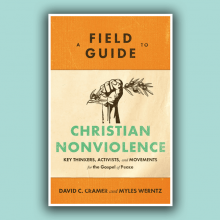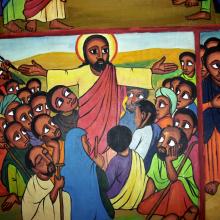James Cone
BLACK LIVES MATTER. In the years since 17-year-old Trayvon Martin was murdered in his hoodie carrying Skittles, we have learned why this phrase is not simply a consequence of all lives mattering. The world systematically devalues Black life, turns Black life into death-bound life, and it is our task — as justice seekers and as Christians — to embrace Black resurrection.
Politically that makes sense, but what does it mean theologically? Surely Christianity proclaims that all might be saved, independent of skin color. A half-century ago, James Cone and fellow Black theologians embraced this theological challenge head-on. They charged that the possibility of life after death for any individual is inextricably linked to the struggle against the death-dealing forces of white supremacy. How might we fill out this insight today, with Black Power slogans themselves finding new life and new form as activists embrace Black joy, Black excellence, Black rage, Black love, and Black dignity?
In a definition that has rapidly gained traction in activist circles, Black prison abolitionist and scholar Ruth Wilson Gilmore defines racism as “the state-sanctioned or extralegal production and exploitation of group-differentiated vulnerability to premature death.” Black studies scholars have refined and deepened this claim, arguing that anti-Black racism names a system of laws, institutions, feelings, and even forms of seeing and thinking that make Black life particularly vulnerable to premature death. Slavery may have ended in the 19th century, but many of the structures and habits that made slavery possible, that made it plausible for Black human beings to be treated as less than human, persist, and those structures and habits function by making Black life precarious. One false move, and the police officer or prison guard or neighbor or privileged “Karen” may invoke the violent power of whiteness to put an early end to Black life.
For most folks, Christian nonviolence evokes unified images of civil rights marches, Vietnam War resisters, and bumper stickers calling us to “turn the other cheek” or “beat swords into plowshares.” Yet Christian nonviolence isn’t a single school of thought, “but rather a rich conversation wrestling with what it means to live out the biblical call to justice amid the complexities of ever-changing political, social, and moral situations.”
One of the reasons I liked going to church was because I loved hearing stories about Jesus. One of the most compelling, yet saddest, stories I heard was about his manger birth. As a little girl, I simply could not understand how people could allow a baby to be born in a cold barn, in a manger. I cried every time we sang, “Away in a manger, no crib for a bed. The little Lord Jesus Lay down His sweet head.” Every time I heard that hymn, I was reminded of the little girl and boy I had seen on that rainy evening. Somehow, I instinctively knew that there was a connection between Jesus’ manger birth and their inner-city life.
Today, we must realize that because someone is aware of the struggle for black freedom in America doesn’t mean they have been moved to action. They may have the right language — even write books, give addresses, give statements — but their actions show a commitment to the status quo rather than social justice.
If racism was and is America’s original sin, and repentance is the only sufficient response to sin, James Cone was the most important theologian of his generation. To white Americans, he said, “Repentance means dying to whiteness.”
James H. Cone, the scholar known as the “founder of black liberation theology,” died April 28, Union Theological Seminary announced. He was 79.
AUG. 9, 2014, is a day I’ll never forget. It was the day that Michael Brown was killed by Ferguson, Mo. police officer Darren Wilson.
For many young people in the United States, especially those of us involved in the Black Lives Matter movement, this was our Sept. 11. We all remember exactly where we were and what we were doing when the news broke of another police-involved killing of an unarmed black citizen.
I was in the final days of a yearlong internship with Sojourners. My fellow interns and I were on our closing retreat in West Virginia. I was on my phone checking my Twitter timeline when I began to see retweets of images: Michael Brown laid out on Canfield Drive with blood still leaking from his bullet wounds. I remember the anger that instantly came over me. “Not another one!” was all I could think.
As the day wore on, I felt frustrated that I was stuck in a retreat house, forced to sit idly by while the grieving community in Ferguson was antagonized by officers in riot gear with police dogs. I knew then that I had to do whatever it would take to join the people in this fight for justice. I never imagined how this movement would change the way I—and many others—actually do theology.
In the wake of Megyn Kelly’s statement that “Jesus was a white man,” critics have quickly and unanimously responded that Jesus was not a white man.
Rev. Laura Barkley debunked Kelly’s statements for Sojourners, noting that Jesus “was a Palestinian Jew in first-century Nazareth.”







